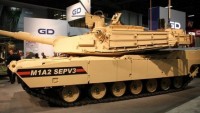Gung Ho + Information Warfare Dominance to Ensure US Marines’ Battlefield Success against China and Russia
| Arthur Dominic Villasanta | | Jan 18, 2017 11:19 PM EST |
(Photo : USMC) Marine Air Ground Task Force components.
"Gung-ho" might not cut it any longer in future battlefields permeated by corrosive information warfare and bedeviled by long-range precision weapons where the U.S. Marines will be the first to fight for freedom.
The Marines' enemy will be the men of the People's Liberation Army Ground Force (PLAGF), China's equivalent of the U.S. Army. While nowhere as sophisticated as the Russian Army, PLAGF has capabilities that will hinder the Marines from accomplishing their battlefield missions as quickly as they should.
Like Us on Facebook
One of these capabilities is China's arsenal of anti-ship missiles that threaten to sink the warships Marines ride on before the Marines can even invade Chinese-held real estate such as its man-made islands in the South China Sea.
The Marines are developing a new warfighting doctrine for a future where the legendary "Gung-ho" attitude of the Marines might not be sufficient to secure victory on future battlefields. In Marine culture, gung-ho means fighting together and working together. It also refers to the "can do" attitude of the Marines in the face of obstacles.
Gung-ho, which became associated with the Marines in World War II, is derived from the Chinese words "kung," which translates into work, and "ho," which means together.
The goal of this new thinking is to get the Marines organized, trained and equipped to meet the demands of a future operating environment "characterized by complex terrain, technology proliferation, information warfare, the need to shield and exploit signatures and an increasingly non-permissive maritime domain."
Lieutenant General Robert S. Walsh, Deputy Commandant of the Marine Corps for Combat Development and Integration, said the Marines "are nearing completion of an extremely exacting capabilities-based review that identified several critical gaps that must be addressed in order to fight and win against highly capable adversaries."
A review by the corps found it needs more sophisticated information warfare capabilities; more unmanned aircraft systems (UAS); active protection systems (APS) for its tanks and combat vehicles and better defenses against airborne and ballistic threats.
"We've got to start modernizing -- we aren't postured for the future fight," said Gen. Walsh.
The Marines will have to adapt to a new warfighting environment where small units will exercise even more autonomy and initiative as they operate in widely dispersed operations, many times cut-off from their leadership
Leadership training down to the most junior officer, therefore, is key to future battlefield success. Past masters of maneuvering at sea, on the ground, and in the air, the Marines will have to learn to master a new science and art: electronic warfare.
Beyond doubt, technology has made the future battlefield much more lethal. Sensors, smart weapons and networks increasingly define modern warfare and Marines will have to dominate "information warfare" to ensure victory.
Information warfare is crucial to Marines' planning. There are now some 7,000 Marines our of the Corps' total strength of 182,000 personnel devoting their energies to this critical warfighting task. And this number is bound to rise.
TagsU.S Marines, People's Liberation Army Ground Force, china, Gung-ho, Lieutenant General Robert S. Walsh, information warfare
©2015 Chinatopix All rights reserved. Do not reproduce without permission
EDITOR'S PICKS
-

Did the Trump administration just announce plans for a trade war with ‘hostile’ China and Russia?
-

US Senate passes Taiwan travel bill slammed by China
-

As Yan Sihong’s family grieves, here are other Chinese students who went missing abroad. Some have never been found
-

Beijing blasts Western critics who ‘smear China’ with the term sharp power
-

China Envoy Seeks to Defuse Tensions With U.S. as a Trade War Brews
-

Singapore's Deputy PM Provides Bitcoin Vote of Confidence Amid China's Blanket Bans
-

China warns investors over risks in overseas virtual currency trading
-

Chinese government most trustworthy: survey
-

Kashima Antlers On Course For Back-To-Back Titles
MOST POPULAR
LATEST NEWS
Zhou Yongkang: China's Former Security Chief Sentenced to Life in Prison

China's former Chief of the Ministry of Public Security, Zhou Yongkang, has been given a life sentence after he was found guilty of abusing his office, bribery and deliberately ... Full Article
TRENDING STORY

China Pork Prices Expected to Stabilize As The Supplies Recover

Elephone P9000 Smartphone is now on Sale on Amazon India

There's a Big Chance Cliffhangers Won't Still Be Resolved When Grey's Anatomy Season 13 Returns

Supreme Court Ruled on Samsung vs Apple Dispute for Patent Infringement

Microsoft Surface Pro 5 Rumors and Release Date: What is the Latest?














